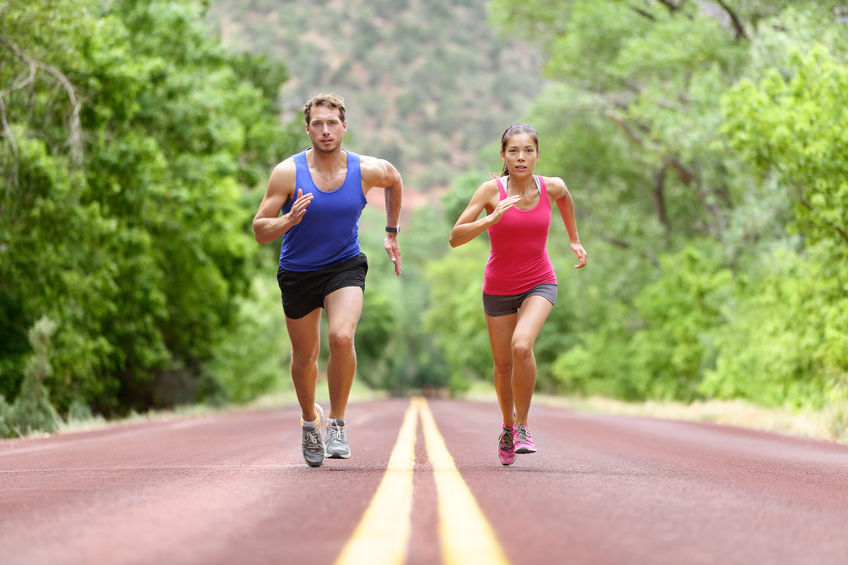Chondromalacia Patella, or “Runner’s Knee”, occurs when repeated stress on the knee causes inflammation and a gradual softening of the cartilage under the kneecap (patella). The inflammation of the cartilage prevents the kneecap from gliding smoothly over the end of the thigh bone (femur) therefore causing pain and swelling of the knee. The underside of the kneecap should be smooth and move within the femoral groove (a groove on the thigh bone). If the kneecap is pulled sideways, it becomes rough like sandpaper and the symptoms appear.
The pain associated with Runner’s Knee normally increases gradually over a period of time, often a year or longer, until it hurts so much that you feel the need to go see your doctor. Symptoms usually occur beneath or on both sides of the kneecap. Pain may be intensified with activities such as a short run, squatting or jumping. Stiffness may occur simply from prolonged sitting or descending stairs.
Runner’s Knee accounts for a quarter of the overuse injuries treated in sports clinics. Teenage girls are most commonly affected, but any active person age 14 or older may experience this pain syndrome.
Over pronation causes the lower leg to rotate inward due to the unstable pronated foot. The kneecap moves in an abnormal side-to-side motion instead of gliding within the normal track of the femoral groove on the thigh-bone. If your quadriceps are weak, Runner’s Knee may develop because the thigh muscles help to keep the kneecap in its proper track. Any muscle imbalance, untreated ligament injury, direct or repeated trauma, or history of trauma to the knee or leg can cause Runner’s Knee.

Short Term Treatment: Avoid any exercise that will put weight on a bent knee. Try to cut back on your activity and try swimming. If the knee is painful or swollen, rest it. Icing the knee for 15 minutes twice daily will help reduce the pain and inflammation. Aspirin or ibuprofen will also keep the pain and inflammation down. Consult a physician about a more sophisticated and effective anti-inflammatory medication.
Long-Term Treatment: Look into physiotherapy, including stretching and strengthening exercise for the quadriceps, hamstrings and calves. You may require orthotic devices to correct any abnormal foot mechanics.
After the causes have been determined and the appropriate measures have been taken, Runner’s Knee should not limit you from any activity.
Shin Splints
The lower leg pain resulting from shin splints is caused by very small tears in the leg muscles at their points of attachment to the shin.
There are two types:
1.) Anterior shin splints occur in the front portion of the shin bone (tibia).
2.) Posterior shin splints occur on the inside (medial) part of the leg along the tibia.
Anterior shin splints are due to muscle imbalances, where dorsiflexion is inadequate making it difficult for the anterior tibialis to do its job. Excessive pronation contributes to both anterior and posterior shin splints.
The pain may begin as a dull aching sensation after running. The aching may become more intense, even during walking, if ignored. Tender areas are often felt as one or more small bumps along either side of the shin bone.
When the posterior muscles, which propel the body forward, are tight, additional strain is placed on the muscles in the front part of the lower leg. These muscles lift the foot upward and also prepare the foot to strike the running surface. Hard surface running increases the stress on the anterior leg muscles, as do worn or improper shoes.
The extra work exerted by the muscles of the foot and leg overwork in an attempt to stabilize the pronated foot and repeated stress can cause the muscles to tear where they attach to the tibia. Any premature increase in running speed or distance can also cause shin splints.
Short -Term Treatment: To reduce inflammation and relieve pain, take aspirin or ibuprofen. Do not take acetaminophen. Ice immediately after you run. For seven to ten days, you should reduce your mileage and intensity. “Running through the pain” is an archaic, abandoned idea. Keep your running surfaces flat and soft. A device called a “varus wedge” can be used to support the inside of the foot and reduce the amount of pronation. Self-enforced treatment of shin splints, as with most overuse injuries, is successful in most cases.
Long-Term Treatment: A sports medicine specialist may need to be seen for persistent problems. They may prescribe strengthening and flexibility programs to correct the muscle imbalance, orthotics devices, anti-inflammatory medication and/or physical therapy involving ice massage, ultrasound, electro-stimuli and heat to reduce inflammation and pain.
The best means of prevention of serious athletic injuries is to maintain good muscle strength and flexibility.
Guest authors offer experience and educational insights based on their specific area of expertise. These authors are contributing writers for the NFPT blog because they have valuable information to share with NFPT-CPTs and the fitness community at-large. If you are interested in contributing to the NFPT blog as a guest, please send us a note expressing your interest and tell us how you can contribute valuable insights to our readers. We look forward to hearing from you! Send to editor@nfpt.com


